The foliage fall mystery
Have you ever wondered what factors determine the leaves falling from trees in the autumn? Or maybe you noticed, that the period, when leaves fall on the ground varies every year. This article is an answer to these two basic questions because the foliage fall phenomenon isn’t so simple as thriving leaves from buds during the spring.
- INTRODUCTION
Deciduous forests are dominant in many regions around the World. All these regions lie in temperate climate zones, in which the biggest feature is the clear presence of 4 times of the year: spring, summer, autumn, and winter. The existence of these 4 periods of the year has mostly climatic background, unlike the calendar. Their occurrence is driven by significant weather changes, which repeat periodically year by year. The coldest part of the year is the time when the deciduous tree is at the lowest level of activity. Saying otherworldly, the tree “sleeps”. In a practical sense, the sap level is kept at a minimum, which prevents the tree from the influence of hard frost. It changes when spring comes. Then all trees likewise other plants start their activity. Deciduous trees start to develop their leaves and other plants start to grow. It seems to be simple to understand, as the main factor behind it is a higher temperature and bigger solar irradiation throughout the day. Another very important meteorological factor determining the pace of both foliage and plant development during the spring is precipitation. Considering these 3 weather elements the foliage development seems to be simple to understand. When the precipitation amount is appropriate and both temperature and the total time of daily solar irradiance grow, then the greenery develops faster and the first greening of spring occurs earlier. In a phenological sense, we are talking about the Spring First Leaf Index, and the next First Bloom Index, when including the bloom period too.
The opposite situation, when autumn is coming looks slightly different and more complicated. There are more factors, which can determine the foliage conditions at the given period, being more precise at the beginning of the last quarter of the year. Before I start to answer which ones mostly determine the end of the deciduous tree biological cycle, I would like to tell what is the NDVI (Normalized Difference Vegetation Index).
2. NDVI – NORMALIZED DIFFERENCE VEGETATION INDEX AND LAND SURFACE PHENOLOGY
The Normalized Difference Vegetation Index (NDVI) is dedicated to measurements of green and healthy vegetation. The NDVI is derivative from DVI (Difference Vegetation Index) dealing with the spectral properties of green plants and their appearance against other image features. The NDVI is a simple graphical indicator based on space remote sensing assessing the live green vegetation presence in the given area. The analyses of the Normalized Difference Vegetation System lead to understanding the causes of variation in spring and autumn timing for a landscape renowned for its biological diversity (Norman, Hargrove, Christie, 2017). The difference in spring and autumn timing for deciduous trees is mostly an effect of seasonal weather variations. Moreover, each of the species has its own distinct life cycle marked by the growth and senescence of leaves combined with their enhanced photosynthetic activity. Each change in foliage amends the electromagnetic radiation reflectance from the land surface, which is measurable by remote sensors. These changes recur year by year, and their timing is called Land Surface Phenology (LSP). Land Surface Phenology is concentrated on the measurements of the aggregate activity of vegetation within a certain area unit bounded by a satellite sensor. It doesn’t provide information about the phenology of individual plants or species. However, when the forest is comprised of a multitude of species, the changes start to be noticeable when one of the species begins to brown down its foliage. Even one kind of tree impacts a general vegetation change despite not always clear specific vegetation attributes captured by this technology. An alternative scientific record of seasonal variations in the vegetation life cycle can be obtained by ground-based web cameras. These cameras can target natural vegetation (i.e. “PhenoCams“) or capture the vegetation accidentally, when visible in their frame.
Combining the NDVI and LSP research, we can understand the seasonal variations in the deciduous tree’s life cycle and the major causes of these seasonal variations. Using remote sensing for the investigation of the seasonal vegetation timing it was found that there are basically two key challenges to understanding these phenomena.
The first key challenge is based on the wide understanding of microclimate, whose properties rely on the local topography. The basic microclimate element, which shapes the difference in vegetation timing is solar radiation. The local topography gradient decides somewhat how much sun receives on the given surface. Definitely important are the altitude and slope aspects. The topographic factor also determines other issues (Fridley, 2009):
– the risk of frost
– summer heat stress
– exposure to drought
In turn, the deciduous forest life cycle difference might vary locally. For example, the forest located at the shaded slope (opposite to the Sun’s path across the sky) will be less capable of extending growth, because of its developments reliant on the air mass passing over the area with only a little influence of solar radiation. Obviously, the importance of topographic attributes affecting exposure to microclimate elements listed above is not constant, especially during the seasonal extremes. On the other hand, these forests located at the slopes exposed to solar irradiation might have brought forward a whole vegetation period. While years with warmer springs can enhance green-up and carbon assimilation, exposure to late growing season drought could limit those gains (Wolf, et al., 2016).
The second key challenge is based on the variable response of species and vegetation to day length and seasonal weather changes. The spring temperature fluctuations explain more year-to-year variation in foliage development, where the response of the individual species is not uniform. Some species achieve their budburst and next maximum leaf expansion earlier than others. A good example of the earliest budburst and leaf expansion is the Prunus Padus, which exists in river valleys as a part of the riparian forests.
Additionally, also the land cover changes (site history) can determine the vegetation life cycle timing.
The Normalized Difference Vegetation Index has its own minimum and maximum. The minimum usually falls after the coldest period of the year at the given location (Cumulative Chili Degree Days CCDD) and the maximum occurs usually in July, before the peak of GDD (Growing Degree Days). The Growing Degree Day is a weather-based indicator for assessing crop development. The maximum value of GDD indicates the best conditions for plant growth (based on the heat accumulated by them and daily temperature changes).
The scale, in which the NDVI is defined is between 0 and 1, so it can be easily shown in percentage values. Regarding the example below, we can see how the NDVI changes for a given altitude in the spring and autumn (Pic. 1).
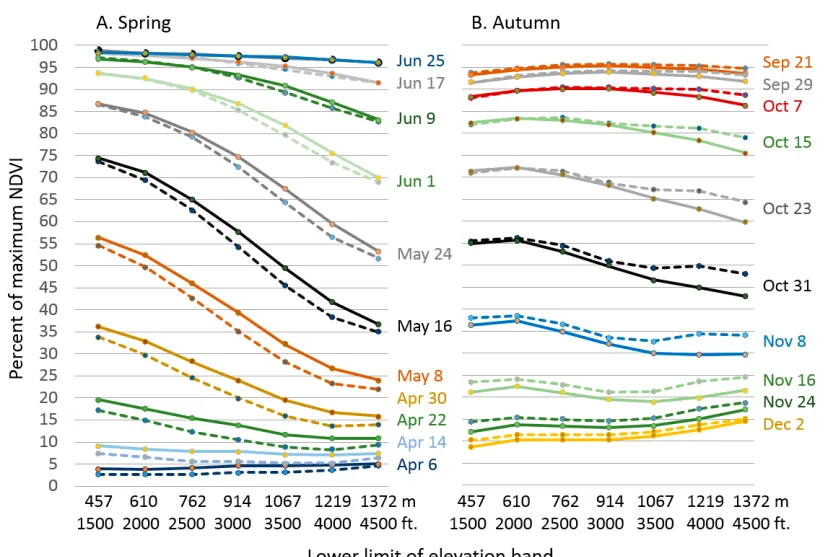
Pic. 1 The NDVI index variations based on the elevation and moisture (mesic – solid lines, xeric – dotted lines) based on 2000-2015 observations in Smokey Mountains (Norman, Hargrove, Christie, 2017).
From the image above we can read, that i.e. at the altitude of 1372m.a.s.l. on June 1 the vegetation development corresponded to 70% of peak value, possible to reach at this altitude throughout the year. Looking at the left pattern, which displays the NDVI values at springtime, we can clearly see the dependency between the altitude (being more precise the temperature) and the stage of vegetation development. It’s transparently a lag in the green-up process between the tops and the bottoms of the mountains. The situation looks different when looking at the right side of this pattern. During the autumn the NDVI is less varied between certain altitudes. The brown-down process is still more advanced at the top of the mountains, but these differences start to be visible in October (more or less in the mid-autumn period). Surprisingly also the lowest altitudes suffer from a quicker foliage fall process, which can be driven by one of the factors described above, which is a possible frost caused by temperature inversion.
This situation can be clearly visible i.e. on Google satellite imagery when we take a look at some mountainous areas (Pic. 2). The vegetation development variations between spring and autumn are considerable.

Pic. 2 A good example of vegetation process variations between spring and autumn regarding the altitude. At springtime in the valleys, the beech forests are green, whereas near the treeline they are still before the leaf buds development. In autumn the situation is completely different, as at entire slopes the stage of the brown-down process looks similar. East Carpathians, Polonyna Krasna, Ukraine (Google Earth/Google Maps).
Another graph shows the relation between the NDVI index and other factors throughout the year based on observations in Smokey Mts (Norman, Hargrove, Christie, 2017).

Pic. 3 The year variations of NDVI based on the research in Smokey Mountains, where: GDD – Growing Degree Days, CDD – Cumulative Chilling Degree Days, PCP – Precipitation, DAYL – Day length, NDVI – Normalize Difference Vegetation Index.
The shape of the NDVI is not symmetrical. It means, that the green-up process during the spring has a different scenario than the brown-down period during the fall. The period, when the leaf drop is observed might take longer, than leaf development, because we are taking into account both leaf coloration and leaf drop as per the pattern below (Pic. 4).
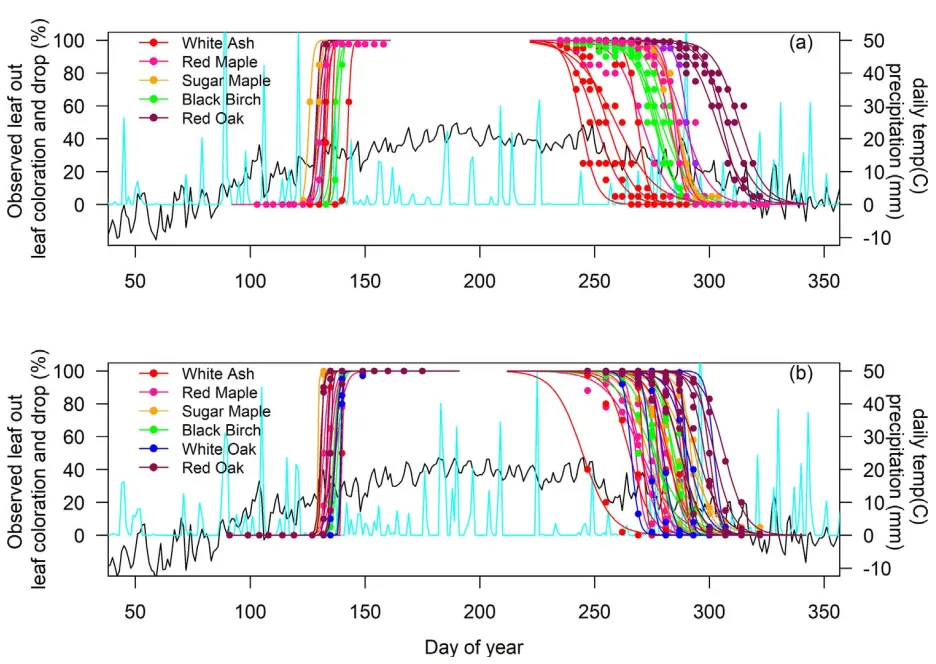
Pic. 4 The pattern, which displays whole leaf phenology based on the one season in 2014 and includes a few common deciduous species. Each line indicates one species. Each dot indicates one observation. These points mark a logistic curve. Blackline shows the temperature changes, and the bluish line indicates the amount of precipitation. The upper pattern shows results from the Uconn Forest, lower pattern presents the results from the Harvard Forest (Yingying, Wang, Wilson, 2018).
The pattern above clearly shows that the fall phenology period is over twice as long as the spring phenology period. The process of leaf coloration and drop doesn’t look so simple and I want to discuss it more below.
3. HOW LEAVES CHANGE THEIR COLOUR
The key thing, which keeps leaves green during the summer is chlorophyll. Chlorophyll is responsible for photosynthesis – the process, which allows plants to absorb energy from light. A large amount of chlorophyll in the plants gives them a green color (Pic. 5). It happens this way, because chlorophyll absorbs mainly the blue and red wavelength, whereas the absorption of wavelength between 500 and 600mm is very little. Photosynthesis is a process, in which plants convert the energy from light into chemical processes (sugars), that are to be further released as organism activities like growing, developing blossom, fruits, etc., and furthermore for food storage during the winter period.
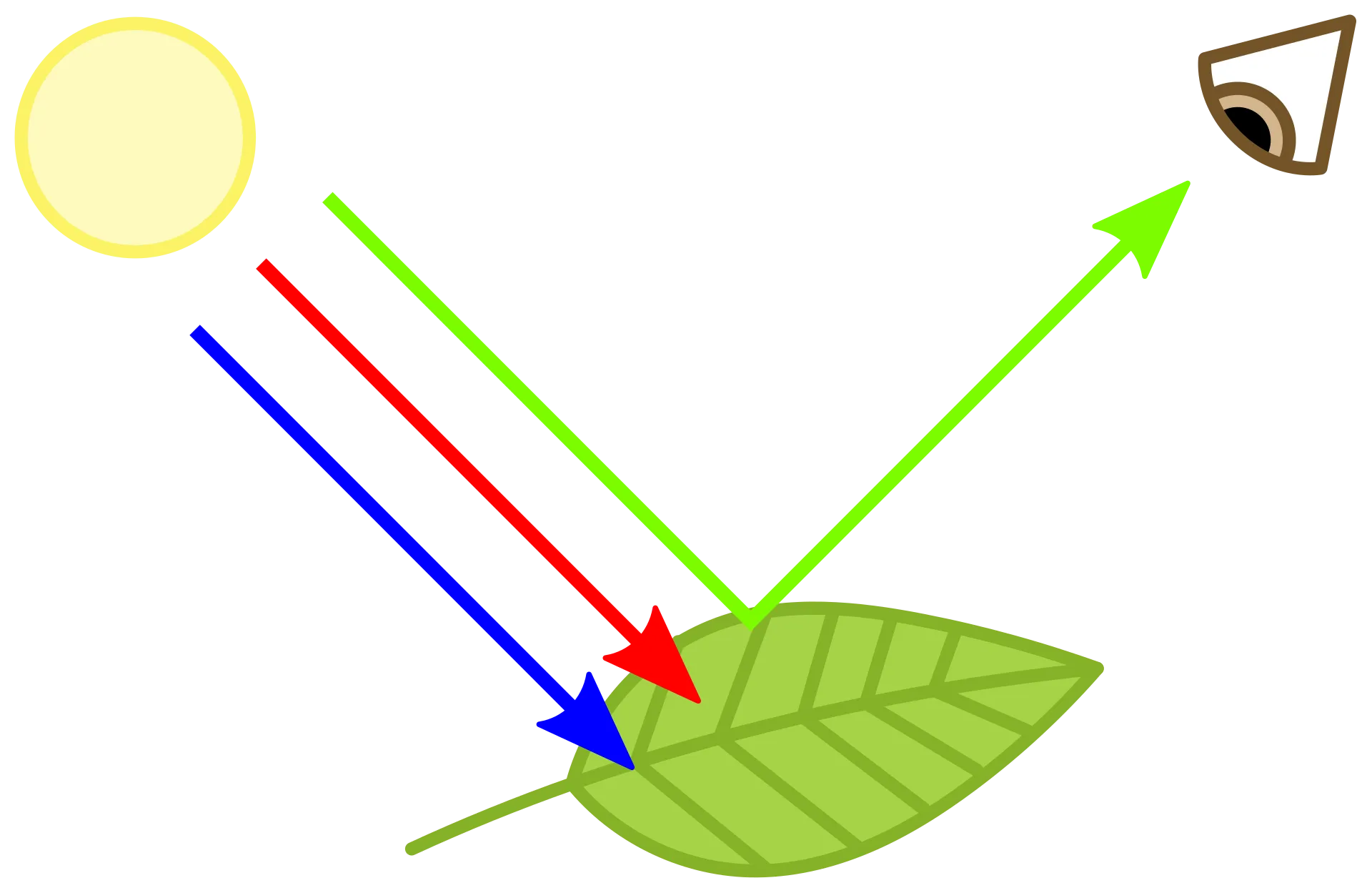
Pic. 5 The chlorophyll gives plants a green color, because of the predominant absorption of blue and red (Wikimedia.org).
When autumn begins, the chlorophyll stops and the pigment starts to degrade and finally stops, because the photosynthesis process slows down as temperature drops. Fresh chlorophyll production stops when nights are cooler. The lower temperature at night results, in the situation, when the cells near the juncture of the leaf and stem divide quickly with no further expansion. This action of the cells creates the abscission layer, which blocks the transportation of materials from the leaf to the branch and from the roots to the leaves. The abscission layer is an array of cells, formed as a corky boundary, which lies at the point where the leaf stem meets a twig or branch. As temperature drops during the night, the abscission layer begins to choke off the veins, that move water into the leaf and foodstuff into the tree. In turn, the leaf veins become narrow trapping all sugars (chemical processes being the result of the chlorophyll) in the leaf. Along with this layer, when autumn progresses, the sap in the tree becomes thicker, making tree veins close. When chlorophyll is blocked from the leaves, it starts to degrade, especially when leaves are exposed to strong sunlight. The phenomenon is analog to paint fainting when exposed to the sun. The chlorophyll degradation process gives a way for other organic compounds to be visible, which were hidden in the greenery during the summer. Now the carotene or xanthophyll (more yellow) pigment becomes prominent. We know them from carrots, pumpkins, or peppers. In autumn they give the leaf a yellow and orange appearance and are best visible under a complete lack of chlorophyll.

Pic. 5 Red maple leaf during the autumn displays the presence of anthocyanins (Don Briggs/ Flickr.com).
High temperature during the day means an efficient photosynthesis process, whereas the chill night causes the aforementioned leaf veins closure, locking these sugars in the leaf. This is a flashpoint to produce anthocyanins, directly from these imprisoned sugars. Anthocyanins, give leaves a red coloration. The trees start to produce anthocyanins in the autumn period. There are at least two reasons, why this group of pigments is produced.
The first one states the lack of chlorophyll needed for retreating the nitrogen from leaves to the branches and other parts of the tree, which obviously will survive the winter period. Another reason is the protection of any kind of insects. When a tree has intensive red leaves, it means that it will be strong next year, and for instance, aphids must lay eggs under the different trees. The third reason is the prevention of frost. Lowering the leaf’s freezing point, the foliage more protection from cold and allows leaves to remain longer on branches, whilst the tree is still able to absorb nutrients. The specific tree species might vary every year, which is driven by the factors described below.
The level of all these pigments is different for an individual tree species. Hence some of the trees are redder in the autumn than others. For example, oaks turn red, because they produce more anthocyanins.
Finally comes the moment, when leaves fall from the tree. This is the moment when the leaf is completely choked off and the abscission layer becomes dry and flakey. It results in the leaf detachment from the tree. The leaf drop can happen quickly, under windy conditions.
When the leaves fall, the trees enter the dormant period, which lasts upon the first greening of spring. We must know that the leaf drop is somewhat self-protection for the tree. Deciduous trees unlike evergreen plants have thin leaves, susceptible to freezing temperatures. Because water expands during the negative temperatures, the tender leaf cells would fracture, making them useless for photosynthesis. The leaves would be unproductive for a whole winter period, exposing the tree to breakages, caused by strong cold winds and the weight of snow collected on these leaves. The trees are brittle in their dormant period, and then prone to breaking. Moreover, the nutrients from decaying leaves are recycled to help grow the next foliage generations.
4. FACTORS DETERMINING THE LEAVES BROWN-DOWN PROCESS AND FOLIAGE FALL
The pivot aim of this article is the explanation, of why the leaves drop at a certain moment, and what aspects decide about both the timing and the pace of this whole foliage fall process. Let’s list and describe separately all of them below:
– temperature – is one of the major factors, it speeds up the leaf coloration, especially when frost occurs from time to time. Warm summer means, that chlorophyll is longer present in the tree leaves. The favorable temperature throughout the autumn period might extend the leaf coloration process, leading it to the very final brown-down stage. Chilling temperatures (about 10 degrees) in August and September combined with the wet summer are very important in affecting the foliage fall timing.
– day length – one of the predominant factors due to decreasing the daily direct sunlight time. It leads to reduced chlorophyll production and other pigments begin to show.
– latitude – as altitude is higher the lower temperatures come earlier. It doesn’t apply really to Europe but is clearly observed across the USA
– wind – gusty winds accelerate the leaf drop from the tree, much earlier before the coloration reaches full development
– rain – near average values keep the chlorophyll longer in the tree leaves
– overcast sky – lack of solar radiation
– drought – causes the earlier leaf drop, when trees suffer from water shortage
– soil moisture – decides about the leaf coloration and their drop timing. An appropriate level of moisture extends the leaf coloration period, leading to its full development. Dry soil can cause earlier leaf drop.
– location against the local relief – when trees grow in low-lying areas, where the cooler air tends to accumulate throughout the night, they usually display their colors earlier, than upland trees. The best example you can see is in the chart above (Pic. 1b).
– tree condition – wounded trees, declined or diseased may display their fall colors earlier than their healthy neighbors. It applies also to single dead branches, wounds to the trunk, or root compaction.
Very important is the weather in summer, especially in late months When i.e. September is unusually warm and dry, then the photosynthesis process is extended. Next, even if after early autumn warm weather suddenly gets worse, the leaf coloration process won’t be much quicker. Unlike good late summer weather, when August or September is cold and rainy, then autumn colors appear faster. The worst scenario occurs when a cold September comes after a rainy summer. The process won’t be slowed down, even if warm and sunny weather back later in autumn.
There are some regularities, determining also the stage of leaf coloration before they fall from the tree. Not always the trees can achieve the stage of red color. Sometimes, under significant weather stressors, they can fall on the ground before the coloration process is completed. Let’s see the individual leaf coloration circumstances based on the weather conditions:
– The brightest leaf colors (i.e. yellow) prevail when sunny autumn occurs after a wet summer or even a whole vegetation period.
– More red and purple pigments can be visible after cool nights following sunny days.
– Quick leaf coloration, caused by rapid chlorophyll disappearance is caused by abundant sunlight and low temperatures
– Foliage fall before the coloration process is completed is typical for late summer and early-autumn drought periods,
– Faint leaf coloration is caused by early occurrences of low temperatures, while frosts, which trigger a premature foliage fall,
– The shortened brown-down period followed by quick leaf drop is caused by swift weather changes including serious temperature fluctuations and windy conditions
– Leaves are not able to develop their colors fully when the autumn is warm and sunny. The whole process is being extended, which results usually in a faint coloration,
– Every frost terminates the leaf coloration because it mostly causes leaf fall
– Drought during the growing period causes the abscission layer to form earlier. In turn, leaves may drop without changing their coloration
– Heavy wind or rain can also cause the foliage to fall before a full coloration development.
– Best leaf coloration with a full brown-down process takes place under long-lasting high-pressure conditions above the region when days are dry and warm and cool, especially frostless nights. However, it must be preceded by a growing season with ample moisture.
– Full leaf coloration process occurs when the soil has been adequately moist over the year and the late summer brings nice and warm weather.
The multitude of factors described above means, that there is no identical fall color displayed at a certain moment year by year. Moreover, leaf coloration can also vary regionally. For instance, leaves in America more often turn red unlike in Europe, where remain mostly yellow. The reason behind this is the resilience of tree species. Whilst in the USA during the repeated ice ages all the species used to escape south, in Europe they died when hit the mountain ranges, i.e. Alps, which gave them no way to escape. In turn, only the most resilient species survived. It applied also to the insects, being in symbiosis with their tree species. These species, which survived all ice ages in Europe became free of insects, whereas their American counterparts did not. As a result, the trees in Europe are not needed to produce the red warning leaves. Due to past climate fluctuations, there are many more arbor species in North America (about 800 and 70 oaks, compared to only 50 and 3 oaks (Ellenberg, 1996)), which results in many more colors in the autumn spectacle.
In conclusion, the best conditions for seeing the most effective leaf coloration in the autumn occur when for a whole year the weather circumstances are favourable. At the beginning of the vegetation season must be wet. Otherwise, when the spring is dry, especially at the beginning of the leaf-growing season, the sealing barrier between tree branches and leaf tend to form earlier than normal. It leads to early leaf drop, often before they have a chance to develop their coloration. The next aspect is the big temperature fluctuation between day and night during the summer, especially late summer and autumn. When sunny day brings warm (not hot, because the temperature optional to the photosynthesis process is about 24-25 Celsius degrees), and night is cool (between 8 and 15 degrees). Cool temperatures at night and abundant sunshine throughout the day destroy the chlorophyll more rapidly, which was explained earlier. Unlike cool, the cold temperature is detrimental, because it kills fragile leaves. The autumn should bring calm days without any gusty winds and rain. Sunny and peaceful days give the time for the build-up of chlorophyll to fade entirely. Unfortunately, it’s still not clear how the autumn phenology of temperate forest tree species responds individually to all these listed factors. However, we should expect diverse sensitivities to stressors in autumn phenology among various tree species.
5. VARIETY OF THE PHENOLOGICAL AUTUMN AND FOLIAGE FALL TIMING
In Poland, for example, the phenologic early autumn begins when the common heater is flowering, and fruits of Common Hazel and Horse Chestnut are ripening. The early autumn precedes the autumn period, marked by Horse Chestnut, Small-leaved lime, and Silver Birch leaf coloring. It’s still far away from the peak of the foliage fall period, which features the best-expressed leaf colouration. It’s obviously the best time for leaf-pipping. Regardless of all aforementioned factors coming through, every single autumn period has its own foliage fall peak, even when the preceding conditions listed above were most unfavorable. It’s understandable, that those fall colors reach their maximum period at some average moment of the year, but taking a detailed glance, we can see that every year is different both for the spring and autumn. It’s shown the best in the graph below (Pic. 6).
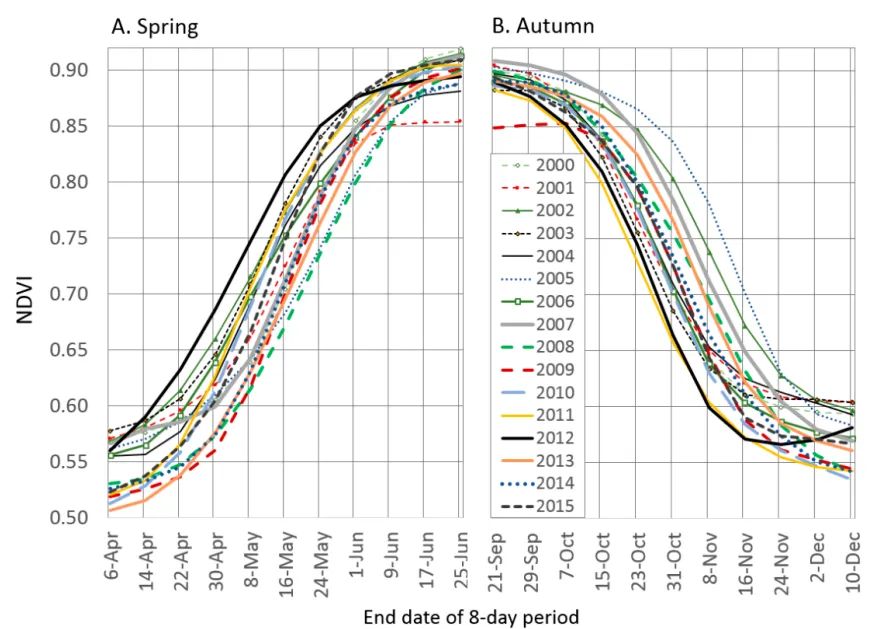
Pic. 7 Spring and Autumn progression timing fluctuations for deciduous forests in the Great Smokey Mountains between 2000 and 2015 year (Norman, Hargrove, Christie, 2017).
The pattern above shows, that when combining all the factors shaping the autumn period, the difference in timing may be substantial. According to observations at Harvard Forest, the timing of leaf coloration, and leaf drop for all species were significantly affected by temperature in autumn, precipitation in spring and summer, drought stress in summer and autumn, heavy rainfall in autumn, and summer heat stress (Yingying, Wang, Wilson, 2018). Moreover, high temperatures in autumn combined with drought-stress situations in summer and autumn can delay the autumn transition period. Usually, each phenological transition date was affected by chilling over the period, of two months prior to the particular phenological event date (Yingying, Wang, Wilson, 2018). It means, that the certain timing of leaf coloration and leaf drop is affected by weather conditions, which occur in August and September.
Looking at the pattern above (Pic. 7) we can spot, that the standard deviations in the autumn transition expressed by onset, peak, and end dates of leaf coloration can vary up to 24 days. These certain date anomalies are different for individual species. The best way to monitor the foliage season timing is by capturing the image of the same place exactly at the same moment of the year. One of the Polish weather info-portals Twojapogoda.pl (Your weather) reports every year what the autumn progress on a certain day is, which for them is October 18. One of the editors comes this day to one of the parks in Wroclaw and takes an image of the same place in the same direction (Pic. 8).

Pic. 8 The Twojapogoda.pl’s project of the autumn progress report year by year on the same day (October 18) in the same place (Park in Wroclaw).
This is the one project such as this, which I know of so far. I realize that this task may be too challenging for us. Fortunately, nowadays, we can check some webcams with a long-term backup and compare the views between the same days in different years. I have prepared some examples for you. The image data comes from October and November. This is an analog to the phenology investigation of phenocams, which cover the same area of vegetation exactly, for a long period. For my purpose, I used the foto-webcam.eu and similar German webcam platforms, which provide high-res images (Pic. 9 – 25).

Pic. 9 The autumn progress in Mariahilfberg (Austria) on October 1 for the period 2013-2020 (asam-live.de). Click to enlarge

Pic. 10 The autumn progress near Pension Weinberg (Italy) on October 5 for the period 2014 – 2019 (foto.weinberg-apartments.it). Click to enlarge.

Pic. 11 The autumn progress near Astental Sadnighaus (Austria) on October 10 for the period 2013 – 2020 (foto-webcam.eu). Click to enlarge.

Pic. 12 The autumn progress in Sistrans (Austria) on October 12 for the period 2014-2019 (foto-webcam.eu). Click to enlarge.

Pic. 13 The autumn progress in Amberg-Sulzbach (Germany) on October 13 for the period 2013-2020 (asam-live.de). Click to enlarge.

Pic. 14 The autumn progress in Unterammergau (Germany) on October 16 for the period 2012-2019 (foto-webcam.eu). Click to enlarge.

Pic. 15 The autumn progress near Hanusel Hof – Golf und Wellness Hotel im Allgau (Germany) on October 18 for the period 2017-2020 (foto-webcam.eu). Click to enlarge.

Pic. 16 The autumn progress in Obersiggenthal – part of Baden town (Switzerland) on October 21 for the period 2014-2019 (foto-webcam.ch). Click to enlarge.

Pic. 17 The autumn progress in Gantkofel, above the Bolzano basin (Italy) between October 25 and October 27 for the period 2013-2019 (foto-webcam.eu). Click to enlarge.

Pic. 18 The autumn progress in Obervellach (Austria) on October 26 for the period 2013-2019 (foto-webcam.eu). Click to enlarge.

Pic. 19 The autumn progress in Munich at Schwabing-Freimann district (Germany) on October 30 for the period 2007-2019 (foto-webcam.eu). Click to enlarge.

Pic. 20 The autumn progress in Wernberg-Duel (Austria) on October 31 for the period 2013-2019 (foto-webcam.eu). Click to enlarge.

Pic. 21 The autumn progress in High Tauern, as seen from Hotel Hohe Brucke in Gasthof (Austria) on November 1 for the period 2011-2019 (foto-webcam.eu). Click to enlarge.

Pic. 22 The autumn progress in Schwarzenbach (Austria) on November 2 for the period 2013-2019 (foto-webcam.eu). Click to enlarge.

Pic. 23 The autumn progress observed around Zeller See (Austria) on November 4 for the period 2012-2019 (foto-webcam.eu). Click to enlarge.

Pic. 24 The autumn progress near Burghausen Castle (Germany) on November 11 for the period 2013-2019 (foto-webcam.net). Click to enlarge.

Pic. 25 The autumn progress in Sunnyvale (CA) on November 20 for the period 2014-2019 (Mpcam.marklex.com). Click to enlarge.
The bulk of the examples above show what the autumn progress looks like on certain dates. Every image represents a separate year. Having an onlook from a few years back, we can see the changes. The autumn landscape isn’t the same across these years. It’s definite proof of the foliage season fluctuations, which has been explained above (Pic. 7).
The autumn transition changes are observed not only in relation to certain days when all the images were captured. They are clearly visible in the spatial layout. Moving far away from the place, where we are all these changes can be noticeable, regarding the local climate circumstances.
Considering Europe and North America, we have opposite situations. The main difference lies in the mountain range orientations. In North America, most of the mountain chains are longitude-oriented, which allows for the loose air mass movement from north to south and the other way round. In practice, it means, that the foliage season gradually moves from north to south, as the day gets shorter and colder air masses advance towards the south. The earliest peak fall colors are observed in the northeast USA and in the Mountains in the west in late September. The latest can be seen in the Mid-Atlantic coast, Southeast coast, and part of the Deep South (Pic. 26).
The video above shows the foliage fall prediction for the USA (Countryliving.com).
In Europe, the situation can be a bit more complicated, because the mountain ranges are latitude oriented. In turn, the air masses are blocked, which causes significant differences in climate features at short distances. It means, that driving 200km south you can see even up to 3 weeks or 1-month difference between southern Poland and northern Hungary. In practice, the leaf coloration peak might be not observed at a certain time, because the brown-down process is advanced on the northern side of the mountains, and leaf coloration starts on the southern side of the mountains. However, the presence of the warm current – Gulfstream marks the climate difference between West and East Europe. It means, that the peak fall season “journey” can be observed firstly in the eastern part in late September of the continent, and later in the western part in November.
In Eastern Asia, the situation is mixed, compared to North America or Europe. Mountain ranges are mostly extended from the north to the south, but the vicinity of the Ocean makes a significant impact on the foliage season timing. On top of that, the Kura Siwo warm current causes a serious lag in the autumn process. In turn, the foliage season in South Japan is to be observed even in early December (Pic. 27).
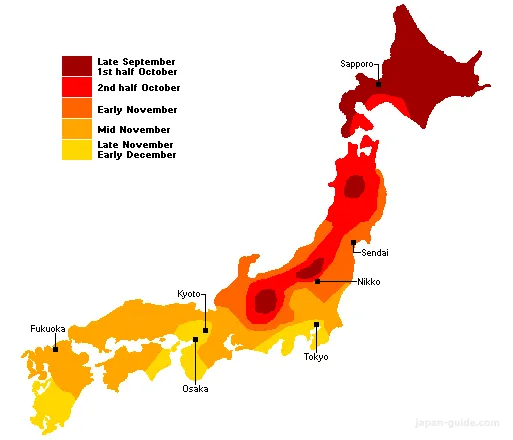
Pic. 27 The autumn fall season in Japan (Japan-guide.com).
The impact of Kura Siwo is blocked by the Japanese mountains. The result can be seen in South Korea when the peak of foliage falls occurs in mid-October (Pic. 28).
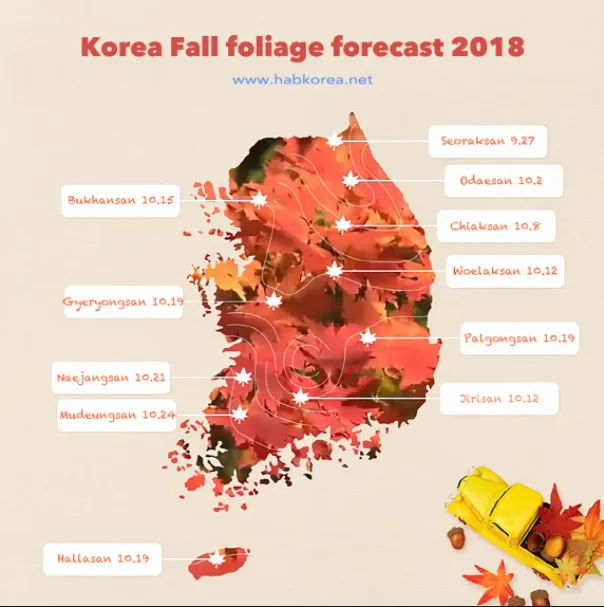
Pic. 28 The foliage fall timing in South Corea (Habkorea.net).
In conclusion, the foliage fall peak occurs for about 3-3.5 months if we consider a whole temperate climate zone. In the northern hemisphere, where most deciduous forests grow it’s a moment between mid-September to early December.
6. LEAF PIPPING – WHAT IS IT?
Leaf pipping is a kind of tourism, where people travel to certain destinations in order to admire the peak of the autumn period. The term has mostly informal meaning and refers to the USA and Canada (especially New Hampshire, Quebec, and Ontario). Regardless of this, the fall color destinations are known also in Europe and Eastern Asia.

Pic. 29 Autumn in New Hampshire (Wikimedia.org).

Pic. 30 The autumn peak in Vermont (Instagram.com/markdphotos).
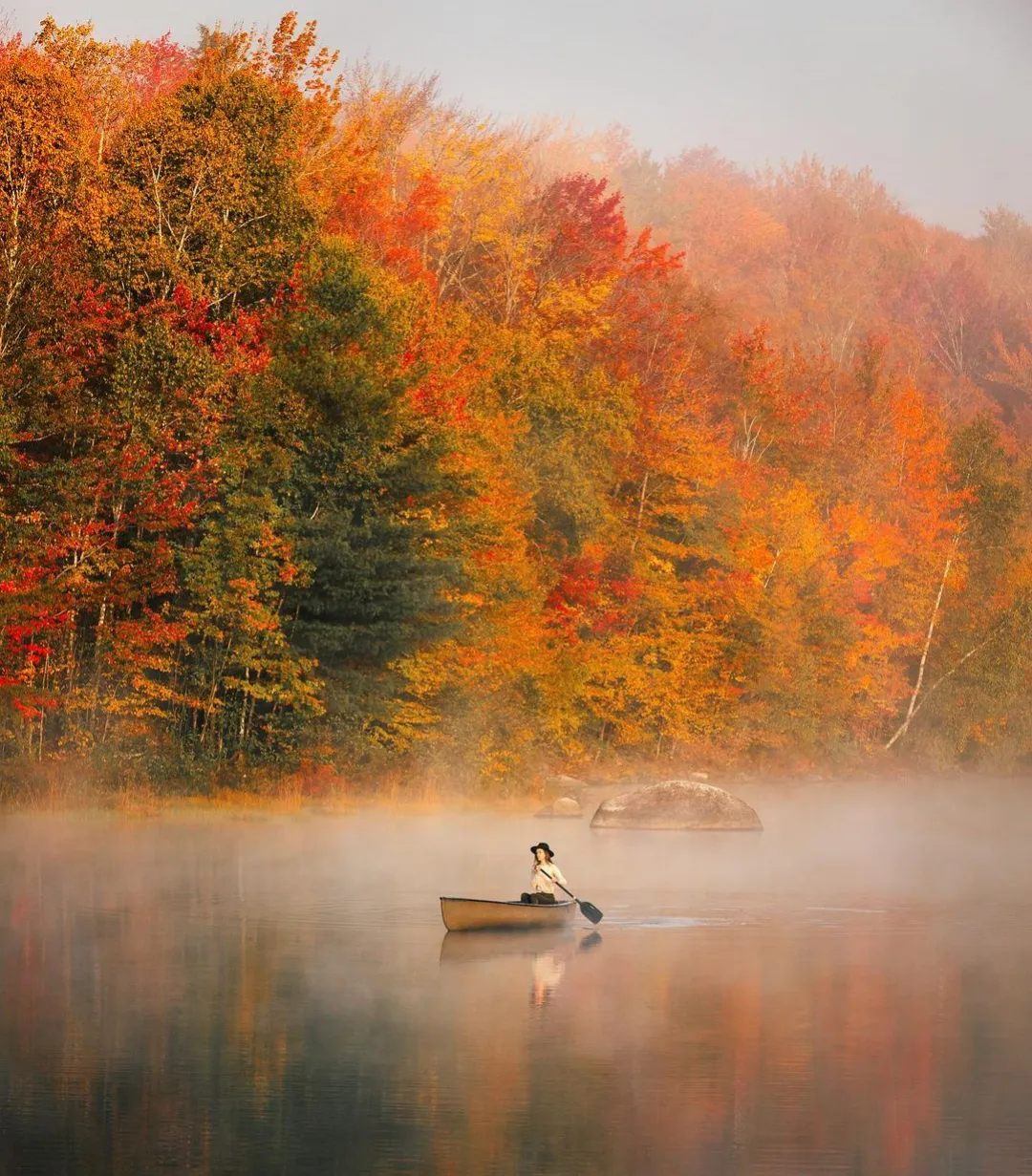
Pic. 31 The autumn peak in Vermont (Instagram.com/driftingphoto).

Pic. 32 The peak of foliage season in Lake District (Richard Walker/Lazytrips.com)
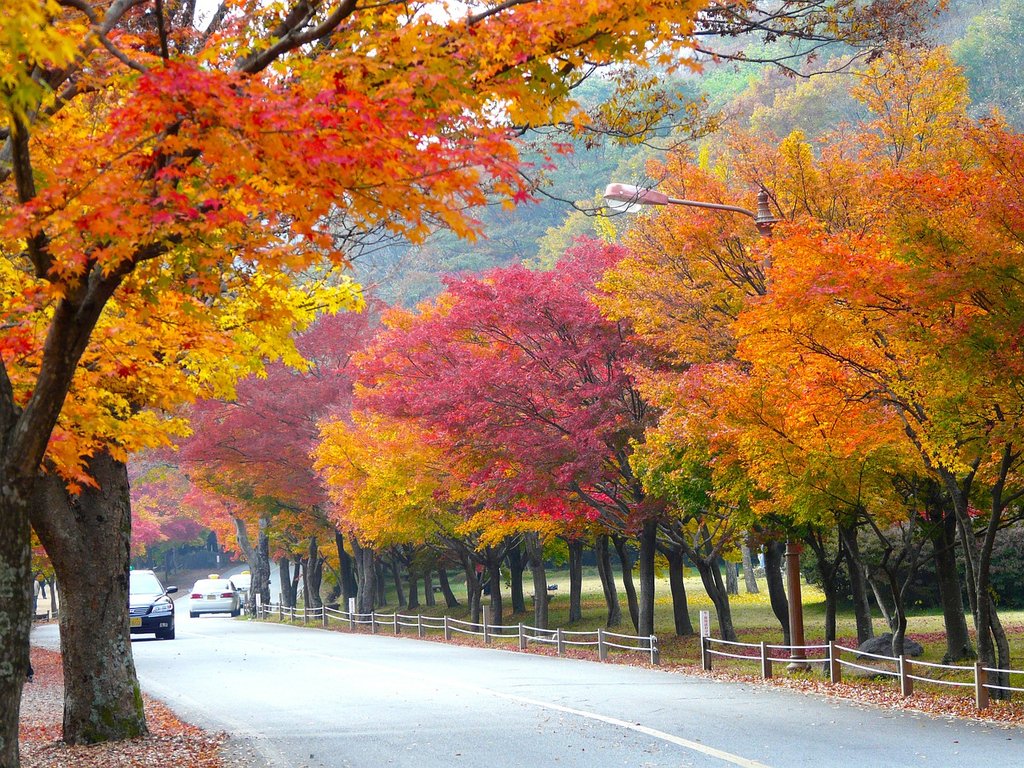
Pic. 33 Autumn at Mount Naejangsan in North Jeolla in South Korea (Cabinzero.com/Pixabay/Sharonang).
French author Albert Camus tells us, “Autumn is a second spring when every leaf is a flower”. It shouldn’t wonder, that a lot of people want to see some places in this spectacular scenery, served by the autumn leaves coloration period. Sightseeing these places and admiring the beautiful autumn colors is often combined with identifying the common deciduous trees by their colours. Sometimes, especially in the USA, the leaf-peeping is a long-lasting tradition, which often results in wealth observation reports.
7. SUMMARY
The foliage fall is known from the temperate climate zones, where areas are mostly covered by deciduous forests. This is a wide-understanding autumn transition including three major moments: the onset, when the leaf coloration process begins, and the peak moment when the leaf coloration is the best developed. It’s called the foliage season or foliage fall period (in Europe and Asia it’s mostly called an autumn fall period). The last moment of the autumn transition is the brown-down process and leaf drop from the tree. This whole autumn period fluctuates every year. The deviations from the standard time of the given autumn moments occurrence can reach even up to 12 days. Most of them are weather-dependent, whereas important is the whole weather scenario from the very beginning of the vegetation process. The spring and summer are crucial with the foliage coloration development during the autumn. It was found, that the best foliage color takes place after a properly humid growing season and dry summer. Next, the weather from late summer and throughout the autumn must be sunny and stable, without any winds and strong precipitation. The pivot thing here is temperature changes in this period. After warm and sunny days, cool nights are vital to full leaf coloration development. Any exceptions from this rule will result in a shortened autumn process or poor leaf coloration. The worst scenario for foliage fall is an early frost, heavy rain, or gusty wind leading to quick leaf drop before its coloration is completed. Another situation with similar results might happen, when after dry and hot late summer and early autumn is followed by sudden atmospheric changes bringing unstable weather with low temperatures. Along with weather conditions, the leaf coloration is shaped by soil moisture.
All the weather and other factors result in not only the various timing of foliage season but also a year-to-year difference in leaf coloration. We must know, that these changes are observed also in spatial terms. Some regions experience the foliage fall season earlier, and others later. The overall timespan for autumn leaf coloration and fall occurrence is about 3-3.5 months considering a whole temperate climate zone. Most of the lands located north of the equator explain the prevalence of deciduous forests in the northern hemisphere. The leaf coloration is also determined by location, especially in the macro-scale range. The best example of this is the different amount of species between Europe and North America. In Europe, the plants were mostly decimated by the Pleistocene climate fluctuations, unlike North America with longitude-oriented mountain ranges giving their opportunity to escape towards the south.
There are still uncertain things regarding tree species behavior during the autumn. The biggest challenge for further studies is an investigation of the autumn phenology responses to climate change. It will definitely change the foliage fall scenario in the near future.
Mariusz Krukar
References:
- Ellenberg H., Ellenberg H., 1996, Vegetation Mitteleuropas mit den Alpen: In ökologischer, dynamischer und historischer Sicht, UTB, Stuttgart; 5th edition
- Fridley J.D., 2009, Downscaling climate over complex terrain: High finescale (<1000m) spatial variation of near-ground temperatures in a montane forested landscape (Great Smokey Mountains) (in:) Journal of Applied Meteorology and Climatology, vol. 48, p. 1033-1049.
- Hanes J.M., Liang L., Jeffrey T., M., 2013, Land surface phenology, (in:) Bioophysical Applicatins of Satellite Remote Sensing, p.99-125
- Howard T., Stoddart J.L., 1980, Leaf senescence, (in:) Annual review of plant physiology, v.31, p. 83-111
- Kepinska-Kasprzak M., 2016, Phenological observations and products of Instutite of Meteorology and Water Management – National Research Institute – Poland, 7th PEP 725 meeting, Vienna
- Wolf S., et al., 2016, Warm spring reduced carbon cycle impact of 2012 US summer drought, (in:) Proceedings of National Academy of Sciences of the USA, 113(21), p.5880-5885.
- Zhang S., Dai J., Ge Q., 2020, Responses of autumn phenology to climate change and the correlations of plant hormone regulation (in:) Scientific reports, v.10
Links:
- https://www.usanpn.org/ – USA National Phenology Network
- http://www.harrisgeospatial.com/docs/BroadbandGreenness.html#NDVI
- https://phenocam.sr.unh.edu/webcam/
- PhenoCam Dataset v2.0: Vegetation Phenology from Digital Camera Imagery, 2000-2018
- PhenoCam Dataset v2.0: Digital Camera Imagery from the PhenoCam Network, 2000-2018
- Multi-Resolution Land Characteristics (MRLC) Consortium
- GROWING-DEGREE DAYS AND DEVELOPMENT OF THE WHEAT PLANT
- Growing degree days (GDD)
- Growing Degree Days – explanation
- https://www.crazynauka.pl/dlaczego-liscie-zolkna-czerwienieja/
- https://www.britannica.com/story/why-do-leaves-fall-in-autumn
- Why Do Leaves Change Color In Fall?
- https://www.twojapogoda.pl/wiadomosc/2019-10-21/niezwykly-projekt-tak-zmieniala-sie-jesien-w-tym-samym-dniu-i-miejscu-na-tle-ostatnich-15-lat/
- https://blog.nwf.org/2014/09/why-leaves-fall-from-trees-in-autumn/
- https://www.metoffice.gov.uk/weather/learn-about/weather/seasons/autumn/autumn-facts
- https://www.fs.usda.gov/visit/fall-colors/
- https://www.canr.msu.edu/news/how_weather_affects_fall_colors
- https://www.thoughtco.com/complete-fall-color-leaf-viewing-guide-1341607
- https://www.thoughtco.com/how-weather-affects-fall-colors-3443701
- https://eu.usatoday.com/story/news/nation/2019/10/01/fall-foliage-how-weather-affect-your-leaf-peeping-year/3831038002/
- Many factors determine vibrancy of fall foliage
- Does a Wet Summer Mean a Brilliant Fall?
- How Does the Weather Affect the Color of Fall Leaves?
- https://www.foto-webcam.eu/
- http://www.asam-live.de/
- https://foto-webcam.ch/
- https://www.foto-webcam.net/
- http://mpcam.marklex.com/webcam/marklex/
- 10 Places in Europe to Admire Fall Foliage
- Why Fall Colors Are Different in U.S. and Europe
- http://kidsinthecity.pl/autumn-leaves-and-fall-foliage-in-poland/
- When do trees turn colors in Japan
- https://weather.com/news/news/2018-09-05-fall-foliage-2018-colors-typical-peak
- https://weather.com/science/weather-explainers/news/2019-09-10-why-peak-fall-foliage-could-be-delayed-warm-september
- Fall foliage map – USA
- Fall foliage prediction map – USA
- Fall foliage map – USA
- Foliage map – Switzerland
- https://alliemtaylor.blog/2019/09/22/best-destinations-in-europe-fall-colors/
- https://www.cntraveler.com/gallery/fall-foliage-around-the-world
- https://lazytrips.com/blog/14-amazing-places-to-see-autumn-leaves-in-europe
- https://blog.eurail.com/fall-colors-europe/
- Top 15 Places to See Autumn Foliage in Asia
- Wisconsin fall color report
- New Hampshire foliage tracker
- https://www.cabinzero.com/blogs/our-journey/best-places-to-photograph-the-gorgeous-fall-foliage-in-asia
- https://wildearth.org/blog/autumn-wonders-1-identifying-common-trees-in-autumn-by-their-colors
- http://www.leafpeepers.com/contents.htm
Wiki:

